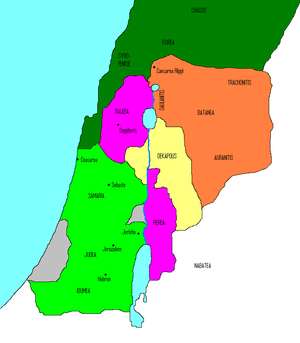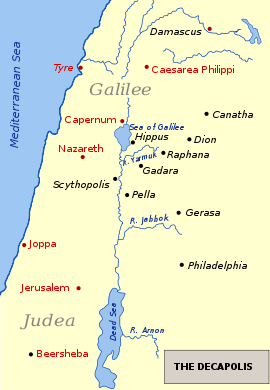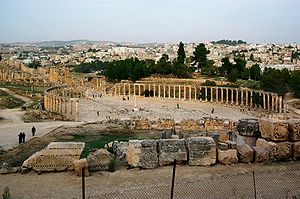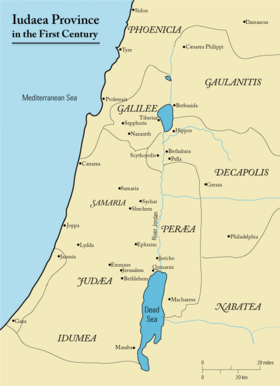- Decapolis
-
For other uses, see decapolis (disambiguation).
The Decapolis ("Ten Cities"; Greek: deka, ten; polis, city) was a group of ten cities on the eastern frontier of the Roman Empire in Judea and Syria. The ten cities were not an official league or political unit, but they were grouped together because of their language, culture, location, and political status. The Decapolis cities were centers of Greek and Roman culture in a region that was otherwise Semitic (Nabatean, Aramean, and Jewish). With the exception of Damascus, the "Region of the Decapolis" was located in modern-day Jordan, one of them located west of the Jordan River in Israel. Each city had a certain degree of autonomy and self-rule.
Contents
The cities
The names of the traditional Ten Cities of the Decapolis come from the Roman historian Pliny the Elder (N.H. 5.16.74). They are:
- Gerasa (Jerash) in Jordan
- Scythopolis (Beth-Shean) in Israel, the only city west of the Jordan River
- Hippos (Hippus or Sussita) in Israel
- Gadara (Umm Qais) in Jordan
- Pella (West of Irbid) in Jordan
- Philadelphia, modern day Amman, the capital of Jordan
- Al Husn in Jordan
- Capitolias (Beit Ras) in Jordan (Dion, Jordan)
- Canatha (Qanawat) in Syria
- Arabella (Irbid), in Jordan
- Raphana in Jordan
- Damascus, the capital of modern Syria; Damascus was considerably north of the others and so is sometimes thought to have been an "honorary" member.
According to other sources, there may have been as many as eighteen or nineteen Greco-Roman cities counted as part of the Decapolis. For example, Abila is very often cited as belonging to the group.
Hellenistic era
Except for Damascus, the Decapolis cities were by and large founded during the Hellenistic period, between the death of Alexander the Great in 323 BC and the Roman conquest of Coele-Syria, including Judea in 63 BC. Some were established under the Ptolemaic dynasty which ruled Judea until 198 BC. Others were founded later, when the Seleucid dynasty ruled the region. Some of the cities included "Antiochia" or "Seleucia" in their official names (Antiochia Hippos, for example), which attest to Seleucid origins. The cities were Greek from their founding, modeling themselves on the Greek polis.
The Decapolis was a region where two cultures interacted: the culture of the Greek colonists and the indigenous Semitic culture. There was some conflict. The Greek inhabitants were shocked by the Semitic practice of circumcision, while various elements of Semitic dissent towards the dominant and assimilative nature of Hellenic civilization culminated gradually in the face of assimilation.
At the same time, there was also some cultural blending and borrowing in the Decapolis region. The cities acted as centers for the diffusion of Greek culture. Some local deities began to be called by the name Zeus, from the chief Greek god. Meanwhile, in some cities Greeks began worshipping these local "Zeus" deities alongside their own Zeus Olympios. There is evidence that the colonists adopted the worship of other Semitic gods, including Phoenician deities and the chief Nabatean god, Dushara (worshipped under his Hellenized name, Dusares). The worship of these Semitic gods is attested to in coins and inscriptions from the cities.
During Hellenistic times the cities were clearly distinct from the surrounding region by their practice of Greek culture; Josephus names several of them in a list of Gentile cities in Judea before the Roman conquest. The term "Decapolis" may have already been used to identify these cities during the Hellenistic period. The term, however, is mostly associated with the period after the Roman conquest in 63 BC.
The Roman general Pompey conquered Judea in that year. The people of the Decapolis cities welcomed Pompey as a liberator from the Jewish Hasmonean kingdom that had ruled much of the area. For centuries the cities based their calendar era on this conquest: 63 BC was the epochal year of the Pompeian era, used to count the years throughout the Roman and Byzantine periods. It is from this time that historians identify the region and the cities with the term "Decapolis."
The Roman Decapolis
The Roman government wanted Roman culture to flourish in the farthest reaches of the empire, which at the time included eastern Palestine. So they encouraged the growth of these ten cities, allowing them some political autonomy within the protective sphere of Rome. Each city functioned as a polis or city-state, with jurisdiction over an area of the surrounding countryside. Each city also minted its own coins. Many coins from Decapolis cities identify their city as "autonomous," "free," "sovereign," or "sacred," terms that imply some sort of self-governing status.
The Romans strongly left their cultural stamp on all of the cities. Each one was eventually rebuilt with a Roman-style grid of streets based around a central cardo and/or decumanus. The Romans sponsored and built numerous temples and other public buildings. The imperial cult, the worship of the Roman emperor, was a very common practice throughout the Decapolis and was one of the features that linked the different cities. A small open-air temple or facade, called a Kalybe, was unique to the region.
The cities may also have enjoyed strong commercial ties, fostered by a network of new Roman roads. This has led to their common identification today as a "federation" or "league." The Decapolis was probably never an official political or economic union; most likely it signified the collection of city-states that enjoyed special autonomy during early Roman rule.
The New Testament gospels of Matthew, Mark, and Luke mention that the Decapolis region was a location of the ministry of Jesus. The Decapolis was one of the few regions where Jesus travelled in which Gentiles (people who are not Jewish) were in the majority. Most of Jesus' ministry focused on teaching to Jews. Mark 5:1-10 emphasizes the Decapolis' Gentile character when Jesus encounters a herd of pigs, an animal forbidden by Kashrut, the Jewish dietary laws.
Later years
The Roman provinces of Syria, Palestina, and ArabiaThe term "Decapolis" fell out of use after the emperor Trajan added the province of Arabia to the Roman Empire in the second century AD. The new province was east of Palestine, so the Decapolis was no longer the Greco-Roman cultural front line. In addition, the cities were grouped into different Roman provinces: Syria, Palestina Secunda, and Arabia. However, the Decapolis remained an important cultural region in the Roman east, even though the term was no longer used. The cities continued to be distinct, distinguished for example by their use of the Pompeian calendar. Historians and archaeologists often speak of the "Decapolis cities" and "Decapolis region" even when referring to these cities in later time periods.
The Roman and Byzantine Decapolis region was influenced and gradually taken over by Christianity. Some cities were more receptive than others to the new religion. Pella was a base for some of the earliest church leaders (Eusebius reports that the apostles fled there to escape the Great Jewish Revolt). In other cities, paganism persisted long into the Byzantine era. Eventually, however, the region became almost entirely Christian, and most of the cities served as seats of bishops.
Most of the cities continued into the late Roman and Byzantine periods. Some were abandoned in the years following Palestine's conquest by the Umayyad Caliphate in 641, but other cities continued to be inhabited long into the Islamic period.
Excavations
Jerash (Gerasa) and Bet She'an (Scythopolis) survive as towns today, while Damascus and Amman (Philadelphia) have become important capital cities. Twentieth-century archaeology has identified most of the other cities, and most have undergone or are undergoing considerable excavation.
See also
- Heptapolis (meaning seven cities)
- Doric hexapolis (six)
- Pentapolis (five)
- Tetrapolis (four)
- Tripolis (three)
References
- Chancey, Mark A. and Adam Porter. “The Archaeology of Roman Palestine.” Near Eastern Archaeology, Vol. 64, No. 4. December 2001. pp. 164–198.
- Epstein, Claire. “Hippos (Sussita).” The New Encyclopedia of Archaeological Excavations in the Holy Land. Vol. 2. Ed. Ephraim Stern. Jerusalem: Israel Exploration Society & Carta, 1993.
- Mare, W. Harold. "Decapolis." Eerdman's Dictionary of the Bible. Ed. David Noel Freedman. Grand Rapids, Michigan: William B. Eerdman's Publishing Company, 2000.
- Parker, S. Thomas. “The Byzantine Period: An Empire’s New Holy Land.” Near Eastern Archaeology, Vol. 62, No. 3. September 1999. pp. 134–171.
- Segal, Arthur. "The 'Kalybe' Structures." Zinman Institute of Archaeology, Haifa University. Online. [1]
External links
- The Decapolis on BibArch
- The Decapolis on the Catholic Encyclopedia
- Scholarly review of a 2003 book, Kulte und Kultur der Dekapolis (Cults and Culture of the Decapolis). The review contains information on the religious syncretism in the Hellenistic and Roman Decapolis. Contains some passages in German.
Categories:- Decapolis
- Greek colonies
Wikimedia Foundation. 2010.




